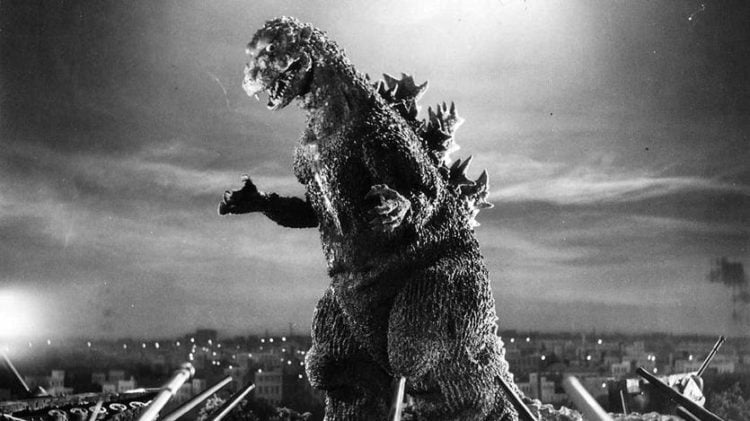
He’s the original monster king, Godzilla, the beast that constantly destroys Tokyo. Indeed, it’s possible that there have been more movies made that feature Godzilla than any other monster in cinematic history, ranging from the increasingly cheesy Toho Studio offerings throughout the late 50’s thru the 70’s to the heavy, dramatic, big-budget recent additions from directors Gareth Edwards (2014’s Godzilla) and Michael Dougherty (2019’s Godzilla: King of the Monsters).
But it all started with a surprisingly tense and engaging 1954 film called Gojira, directed by Ishiro Honda. It’s in Japanese and oh, it’s very 50’s Japan in its culture and outlook. Confusingly, there was a second cut of the movie called Godzilla: King of the Monsters with the addition of Raymond Burr that was released in the United States in 1956. Watching both is darn interesting, but if you have the choice, the original Gojira is far better.
You think you know the story of Godzilla from all the sequels, but in the original, he’s a beast from the ocean depths who terrorizes various Japanese islands after having been disturbed by hydrogen bomb test explosions in the ocean. He’s not happy at all and we learn from the humble fishermen of the tiny fictional island of Odo that he’s sporadically disrupted fishing season for decades. Previously when fishing got really bad, the village would sacrifice a young girl to Gojira by pushing her into the ocean, never to be seen again.
This time it’s modern 1950’s Japan, still recovering from the end of World War II, and it’s their military prowess that’s going to save the day and kill Gojira once and for all. Except he’s surprisingly impervious to everything, from a huge electric fence built around a harbor to tanks and artillery fire. Meanwhile, paleontologist Kyohei Yamane (Takashi Shimura) wants to study Godzilla and understand how the creature survived the h-bomb explosions. Yamane is right in some sense because it’s clear that weapons are not going to kill Godzilla.
Fellow scientist Daisuke Serizawa (Akihiko Hirata) has meanwhile invented a mysterious mechanism that might just be able to overcome our favorite roaming dinosaur, but he’s horrified by what he’s created and insists it will never be used by anyone on Earth. He’s part of a love triangle too, engaged to Yamane’s daughter Emiko (Momoko Kochi). But Emiko has broken off her engagement in favor of the dashing salvage ship captain Hideto Ogata (Akira Takarada), though she’s neglected to give Serizawa that particular news update.
There are many reminders of the recently ended war (WWII), including a horrific injury that Serizawa has incurred, coy references to fragile relationships with other nations that could be disrupted if the Japanese complain about the H-bomb tests that have awoken Godzilla, and people on a train car talking about the dangers of radiation and the need to evacuate Tokyo. But the genius of this movie is in the narrative itself: It’s science that’s awoken Godzilla and it can only be science that overcomes him before the end of mankind. Science as danger and cure both, sprinkled with a love story and, yes, Godzilla destroying Tokyo!
Gojira is absolutely a film worth watching and far deeper and more nuanced than you might expect. The self-doubt and angst that Serizawa feels as he has to decide whether his mysterious weapon should be utilized to destroy Godzilla. The frustration of scientist Yamane who wants to study, not kill, this marvelous creature. The regular Japanese people who are recovering their national identity just to have nature itself threaten their life and precious island home. The growing relationship between the well-meaning Emiko and her beau Hideto. It adds up to a monster movie that’s well worth a watch if you can find it. Just make sure Raymond Burr isn’t in the cast.
